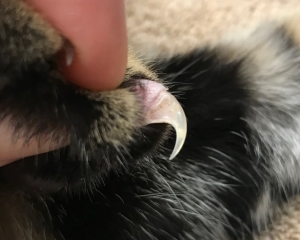Since the early 1990’s people have been questioning whether it is ethically correct to be declawing cats just for the ease of living with them. Many cat owners in the past would choose to declaw their cats at the time of spaying or neutering as per the recommendations of their veterinarians. Younger cats tend to heal quicker than their older counter-parts. Declawing was performed to prevent cats from scratching on furniture or the people they live with. Especially kids. The problem with this was two-fold. As a veterinary profession, we were led to believe that fewer pets would be surrendered to shelters because their owners would enjoy them more by not having to be stressed by inappropriate behaviours and secondly, we were performing these procedures prior to even knowing whether a specific cat would even behave in that manner.
What we do know, declawing is the equivalent to amputating all of your fingers at the first joints. The word implies that it is only the nail that is permanently removed but in actuality it’s the whole first section of bone. Studies over the years have been inconclusive as to whether certain behaviours occur because cats have been declawed. (Inappropriate urination, increase in biting behaviour)
In recent years, many provinces have banned the procedure altogether. Nova Scotia, British Columbia and PEI, all have a ban currently in place, with Newfoundland/Labrador will as of January 2019.
So where do we stand here in Ontario? Some of us still feel declawing has it’s place. People that are immuno-compromised may under a doctor’s recommendation choose to declaw their cat(s) to protect the health of themselves or a child.
So, what do we do instead? Trimming your cat’s nails from an early age is a simple way of making sure the sharp, pointy claws won’t even cause an impact. Nail caps can be applied to cats that persist to scratch. Providing and teaching your cat the appropriate places to scratch.
Pheromones can be applied to help entice cats to scratch in appropriate area(s) and to avoid others (Feliway and/or Feliscratch). Scratching posts with catnip rubbed on them many times helps entice them to use the area.
If you have any questions, as always, feel free to contact us at 905-846-3316


